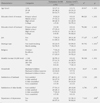Abstract
Purpose
This study aimed to examine postpartum depression of Vietnamese married immigrant women and Korean women, and to identify factors that affect postpartum depression.
Methods
Subjects of one hundred and thirty-five women who had delivered a baby within 3 years were part of the study. Of these women, sixty were Vietnamese married immigrant women and sixty -seven were Korean women living in Gangwon Province. Kim's (2005) Korean version of Cox's (1987) EPDS (Edinburgh Postnatal Depression Scale) was used to evaluate postpartum depression. The reliability of the entire subjects was Cronbach's α=.677, Vietnamese women .743, and Korean women .654.
Results
There were significant differences between the two groups in demographic data and obstetric history. There were significant differences in EPDS (t=-0.236, p=.814) of the type of household between the two groups. Korean women experienced more depression in the items of EPDS 1,2,5, and Vietnamese women experienced more depression in the items of EPDS 7, 8, and 10 when comparing item by item. The influencing factors of EPDS in entire subjects were marriage type, satisfaction of relationship with the husband and other household extended family members, and emotional experience during pregnancy.
Figures and Tables
Table 2
Comparison of EPDS between Vietnamese Women and Korean Women and EPDS of Entire Subjects by Demographic Data

References
1. Ahn Y.-M., Kim J.-H. Comparison of maternal self-esteem, postpartal depression, and family function in mothers of normal and of low birth-weight Infants. Journal of Korean Academy of Nursing. 2003. 33(5):580–590.
2. Beck C.T. Predictors of postpartum depression: An update. Nursing Research. 2001. 50(5):275–283.
3. Beck C.T. Theoretical perspectives of postpartum depression and their treatment implications. MCN. The American Journal of Maternal Child Nursing. 2002. 27(5):282–287.
4. Cox J.L., Holden J., Sagovsky R. Detection of postnatal depression: Development of the 10-item Edinburgh Postnatal Depression Scale. The British Journal of Psychiatry. 1987. 150:782–786.
5. Cho E.J. Subjective sleep quality in depressed and non-depressed mothers during the late postpartum period. Korean Journal of Women Health Nursing. 2009. 15(2):108–120.
6. Cho O.L., Park J.M., Seol D.H., Shin K.Y., Lee S.H., Lee E.J., et al. A study of social policies for multicultural and open society. 2006. Seoul: Presidential Committee on Social Inclusion.
7. Choi E.S., Oh J.A. A study on the factors related to postpartum depression in postpartum women. Journal of Korean Academy of Women's Health Nursing. 2000. 6(3):358–371.
8. Horowitz J.A., Murphy C.A., Gregory K.E., Wojcik J. A community-based screening initiative to identify mothers at risk for postpartum depression. Journal of Obstetric, Gynecologic, and Neonatal Nursing. 2010. 12. 01. doi: 10.1111/j.1552-6909.2010.01199.x.
9. Jeong G.H., Koh H.J., Kim K.S., Kim S.H., Kim J.H., Park H.S., et al. A survey on health management of during pregnancy, childbirth, and the postpartum of immigrant women in a multi-cultural family. Korean Journal of Women Health Nursing. 2009. 15(4):261–269.
10. Jung M.H., Kim J.I. A study on the relationship among prenatal emotional status, preparation for delivery, postpartum social support and postpartum blues. Korean Journal of Women Health Nursing. 2005. 11(1):38–45.
11. Halbreich U., Karkun S. Cross-cultural and social diversity of prevalence of postpartum depression and depressive symptoms. Journal of Affective Disorders. 2006. 91:97–111.
12. Kim E.S. A study on analysis of the actual status on multicultural families and suggestions of the policy in Gangwon-do. 2010. Chuncheon: Research Institute for Gangwon.
13. Kim J.I. A validation study on the translated Korean version of the Edinburgh postnatal depression scale. Korean Journal of Women Health Nursing. 2006. 12(3):204–209.
14. Kim J.-W., Kim J.-H., Eun D.-S., Kim H. Psychosocial and obstetric predictors of depressive symptomatology at postpartum 4 weeks. Korean Journal of Obstetrics and Gynecology. 2005. 48(4):901–909.
15. Kim J.Y. Psycho-social predicting factors model of postpartum depression. 2003. Seoul: Sungshin Women's University;Unpublished master's thesis.
16. Kim H.J. Cross-border marriages between Vietnamese women and Korean men: The reality and problems (A view from Vietnam). East Asian Studies. 2007. 52(1):219–253.
17. Kim H.J. A study of spousal support, the demand for health education, and quality of life for married female immigrants. Korean Journal of Women Health Nursing. 2008. 14(1):5–11.
18. Kim L.H., Kim S.Y., Kwon B.H. A clinical study on the postpartum depression. Journal of Oriental Neuropsychiatry. 2000. 11(2):123–130.
19. Kim M.W., Yang H.S., Kim J.R. A study on agreements among screening tests and related factors with postpartum depression. Korean Journal of Obstetrics and Gynecology. 2009. 52(11):1133–1143.
20. Kim Y.-K., Hur J.-W., Kim K.-H., Oh K.-S., Shin Y.-C. Clinical application of Korean version of Edinburgh Postnatal Depression Scale. Journal of Korean Neuropsychiatric Association. 2008. 47(1):36–44.
21. Lee D., Yip A., Chan S., Tsui M., Chung T. Postdelivery screening for postpartum depression. Psychosomatic Medicine. 2003. 65:357–361.
22. Lee S.O., Yeo J.H., Ahn S.H., Lee H.S., Yang H.J., Han M.J. Postpartum depressive score and related factors pre- and post delivery. Korean Journal of Women Health Nursing. 2010. 16(1):29–36.
23. Lim S.J., Oh S.S., Han G.S. Predictors of depression and anxiety among foreign wives through marriage migration. Korean Journal of Woman Psychology. 2009. 14(4):515–528.
24. Park Y.-J., Shin H.-J., Ryu H., Cheon S.-H., Moon S.-H. The predictors of postpartum depression. Journal of Korean Academy of Nursing. 2004. 34(5):722–728.
25. Polit D.F., Beck C.T. Nursing research: Generating and assessing evidence for nursing practice. 2008. Wolters Kluwer/Lippincott Williams & Wilkins.
26. Rho K.H. An exploratory study on the depression of Vietnamese immigrant women: Focusing on metropolitan area residents. 2009. Seoul: Yonsei University;Unpublished master's thesis.
27. Marriage statistics in 2010. Statistics Korea. 2010. Retrieved July 10, 2010. from http://kostat.go.kr.
28. Teissedre F., Chabrol H. Detecting women at risk for postnatal depression using the Edinburgh Postnatal Depressive Scale at 2 to 3 days postpartum. Canadian Journal of Psychiatry. 2004. 49(1):51–54.
29. Youn H., Lee Y.-H. Mental health of vietnamese migrant wives married to Koreans: Focus on urban-rural differences. Korean Journal of Clinical Psychology. 2010. 29(3):659–684.
30. Yeo J.H. Postpartum depression and its predictors at six months postpartum. Korean Journal of Women Health Nursing. 2006. 12(4):355–362.




 PDF
PDF ePub
ePub Citation
Citation Print
Print






 XML Download
XML Download